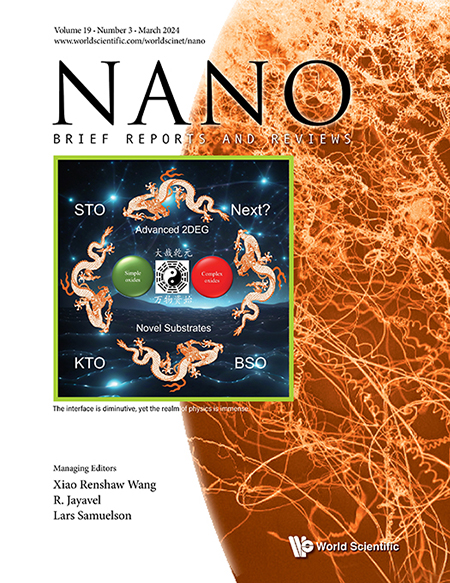Volume 19, Issue 03 (March 2024)
Review for Novel 2DEG Based on Diverse Oxide Substrates
- Hang Yin,
- Shuanhu Wang, and
- Kexin Jin
2430001
https://doi.org/10.1142/S1793292024300019

All-oxide heterostructures with interfacial 2DEG has been showing various interesting phenomena but are mostly fabricated based on STO and KTO. To give a more detailed knowledge about other novel oxide substrates, a review about novel substrates that may host 2DEG are done, including stannate oxide, niobate oxide, scandate oxide, germanate oxide and some simple oxides. The forming mechanism and testing methods of 2DEG are discussed. This could inspire the related research and can be helpful in finding novel oxide substrates.
Research on Denoising Algorithm of Composite Thermal Wave Detection Image Based on Improved Total Variation
2350035
https://doi.org/10.1142/S1793292023500352

Discover the cutting-edge algorithm for high-resolution improvement and noise elimination in infrared thermal wave detection images. Our innovative composite image enhancement technique, based on edge adaptive total variation, outperforms traditional methods. The improved directional model provides better structural information, optimizing the guidance filter process. Experimental results reveal its superiority in objective evaluation and subjective vision. This algorithm effectively eliminates noise and ladder effect while highlighting image details, validating its remarkable effectiveness.
Design of Reversible Quantum Vigenere Cryptographic Cipher in QCA and IBMQ Platforms for Secure Nanocommunication
2450013
https://doi.org/10.1142/S1793292024500139

In this article we first designed reversible gates, Peres gate and DG gate in Quantum Dot Cellular Automata (QCA) and the same in IBMQ. Using these two gates we achieve the reversible vigenere cipher. Encoder and decoder circuit is designed to achieve this.
Composite Molecular Sieve ZSM-5/MCM-48-Based Impregnation Modification for Efficient Adsorption of CO2
- Xuecong Ma,
- Linlin Geng,
- Yu Li,
- Jianwen Wei,
- Lei Liao, and
- Dunqiu Wang
2450014
https://doi.org/10.1142/S1793292024500140

The composite molecular sieve ZSM-5/MCM-48 was obtained by a two-step crystallization method. Tetraethylenepentamine (TEPA) and polyethyleneimine (PEI) were used as impregnation modifiers to modify ZM with amine groups. This work demonstrates that impregnation modification of the composite molecular sieve to achieve efficient CO2 adsorption has practical application significance.
Design and Evaluation of a New Nanoscale and Cost-Efficient Coplanar Digital Parity Generator Based on Quantum Dots
- Zichen Wu,
- Yicheng Wang, and
- Bin Gu
2450017
https://doi.org/10.1142/S1793292024500176

Quantum dot-Cellular Automata (QCA) offers a new platform where binary data is represented by polarized cells that are defined by the electron configurations. Therefore, a coplanar 4-bit parity generator is suggested in this work. This new arrangement eliminates complicated crossovers and provides complete access to all input and output pins. An XOR gate is used to implement the suggested architecture. Simulation waveforms and performance data confirm the proposed circuits' functioning and advantages. The suggested four-bit parity generator uses less overhead than its equivalents. We simulated and tested the suggested circuit with the assistance of the QCADesigner 2.0.3 simulator. The QCADesigner software findings demonstrate that the suggested design is simpler and less expensive than earlier designs. Compared to the present best design, the suggested four-bit parity generator reduces cell number and latency by 55.29% and 40%, respectively.
Variable Length and Temperature-Dependent Analysis of MLGNR at Nano-Scale Regime
2450019
https://doi.org/10.1142/S179329202450019X

The impact of temperature on the MFP of GNR is analyzed for three different technology nodes i.e. 32nm, 22nm and, 16nm at global lengths. It was observed that as temperature (200–500K) rises, the effective MFP of GNR decreases, which further influences its parasitic affecting the performance (delay & PDP) of MLGNR for three different technology nodes at global interconnect lengths (500–2000μm). The results show that MLGNR performs significantly better than copper interconnect viz. delay and PDP perspectives for varied temperatures and different global interconnect lengths.
One-Step Synthesis of Alkali Metal-Hydroxyl Double Modified Graphite Phase Carbon Nitride and Photocatalytic Degradation of Phenolic Compounds
2450023
https://doi.org/10.1142/S1793292024500231

A novel potassium ion-hydroxyl double modified g-C3N4 with outstanding phenol degradation ability was synthesized in one step.

